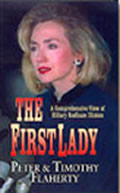Other
Metcalf
Articles:
WEARING TWO HATS
By Geoff Metcalf
May 14, 2007
NewsWithViews.com
�Many said selfishness was the flaw of our modern age; but then self-conceit emerged from a corner of the deepest hell to join selfishness.� --Franz Grillparzer
Once upon a time, the military reserve components (National Guard and Reserves) served to supplement the U.S. military. More recently, (as at our founding) they have become a complementary force.
Approximately 80 percent of National Guard and military reservists have served in either Afghanistan or Iraq since 2001. Some of those reserve component troops have been deployed more than once. My old battalion commander told me of an E-9 in Rhode Island who was over �there' on his fifth tour!
In World War I, the National Guard made up 40% of the U.S. combat divisions in France; in World War II, National Guard units were among the first to deploy overseas and the first to fight. [Read]
Meanwhile, former New Mexico Adjutant General, Major General Melvyn S. Montano is complaining now that because of overstretched deployments, the guard can�t respond to local emergencies. Duh?!
"The National Guard, our nation's first responder to hurricanes, forest fires, tornadoes and other natural disasters, is not as prepared as they should be,'' Montano said in the Democratic Party's weekly radio address.
What the myopic Montano fails to recognize is the state mission is secondary, and that the mission oriented training is for war fighting. State emergencies come after the federal requirements. States may not like that, but hey�that is the deal.
States have been spoiled and grown dependent on the National Guard when tornadoes, hurricanes, forest fires and natural disasters strike. However, those very assets (helicopters, planes, heavy equipment and personnel) are there because of the dual mission of the reserve components.
About a year ago, I observed, National Guard troops serve two masters, and both have been very demanding. The Pentagon tasks Guardsmen to meet national force requirements. The governor tasks Guardsmen in the event of statewide emergency.
Mission-oriented training is imperative to all reserve component units. Once upon a time, reserve component units and individuals were used primarily as �supplemental' assets. They were used to replace stateside active-duty troops during overseas deployments. However, as times, assets, reduction in forces (something you can thank the Clinton administration for), and priorities changed, so did the role of the reserve components.
The Clinton administration pruned the military with a chain saw.
- 709,000 regular
(active duty) service personnel
- 293,000 reserve
troops
- Eight standing
army divisions
- 20 air force
and navy air wings with
- 2,000 combat aircraft
- 232 strategic bombers
- 13 strategic
ballistic missile submarines with
- 3,114 nuclear warheads on 232 missiles
- 500 ICBMs with 1,950 warheads
- Four aircraft
carriers
- 121 surface combat
ships and submarines,
- plus all
the support bases
- shipyards
- And logistical assets needed to sustain such a naval force.
- plus all
the support bases
Those military assets have been eliminated by civilian political policy wonks.
Even as Iraq and Afghanistan requirement rely on reserve component commitments, the international geopolitical macro picture suggests that �something somewhere' (Iran, North Korea, Syria, India/Pakistan, or even Africa) could require troop activations the Pentagon cannot meet with current force structures.
Some states that face a disproportionate number of state emergency activations could/should explore the benefits of creating disaster mission-oriented special units. But that costs money honey. And a key logistics challenge for both states and the feds is funding.
Frankly, one of the reasons National Guard troops get federal money and expensive toys is the government investment in the potential of utilizing the mixed-use assets. States benefit from the military table of organization and equipment (airplanes, helicopters, vehicles, radios, etc.) without having to actually pay for it. When state troops are federalized, the Pentagon gets to realize the return on its investment.
States score when the Pentagon isn't using reserve component resources. However, when (like now) state resources ARE being tasked by the Pentagon, states can (and will) be challenged with the potential of a statewide emergency with insufficient resources.
The deal is: the military provides the equipment and training �on the come.� States get the advantage of the resources as they wait (like firemen) in the hope they won�t be needed. However, when they are needed, they have a very real moral and ethical responsibility to answer that call.
|
Subscribe to the NewsWithViews Daily News Alerts! |
If states don�t like the deal, they could try to opt out. However, there are consequences to reverting to primarily state controlled entities. The most significant is the loss of federal facilities, equipment AND money (just one C-130H costs over $30-Million).
� 2007 Geoff Metcalf - All Rights Reserved
"Geoff Metcalf is a nationally syndicated radio talk show host for TALK AMERICA and a veteran media performer. He has had an eclectic professional background covering a wide spectrum of radio, television, magazine, and newspapers. A former Green Beret and retired Army officer he is in great demand as a speaker. Visit Geoff's
Web Site: www.geoffmetcalf.com. While you're at it - pick up a copy of Geoff's latest book!
E-mail: geoff@geoffmetcalf.com
Approximately 80 percent of National Guard and military reservists have served in either Afghanistan or Iraq since 2001. Some of those reserve component troops have been deployed more than once.












